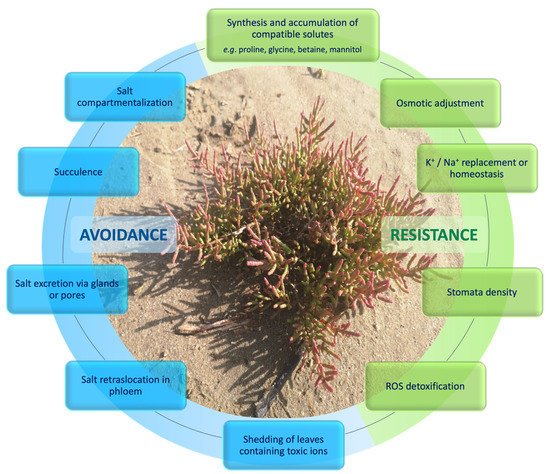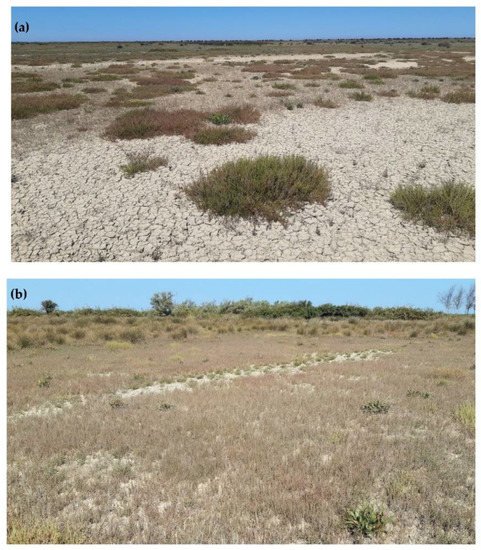Halophytes represent an ancient and remarkable ecological group of annual or perennial plants with very complex features, whose definition and classification are still not univocal and often controversial. The species belonging to this group are very different from an ecological, morpho–physiological, and taxonomic point of view. Therefore, their definition can be subjective and vary a lot in the literature according to the different interpretations. However, following the most popular definition used in the literature, halophytes can be identified as plants that grow naturally, and complete their life cycle in environments that contain a higher salt content than most plant species can tolerate.
- salt tolerance
- Salicornia
- Suaeda
- Atriplex
- Portulaca
1. Introduction
2. Classification of Halophytes

2.1. Response to Internal Salt Content
2.2. Eco-Physiological Aspects
-
Obligate halophytes, mostly the Amaranthaceae members, are species with optimal growth at moderate or high salinity (NaCl 0.1–5.0%); they cannot grow at lower salinity, as they require salt as part of their nutrition to activate or de-activate several salt-sensitive enzymes. These species frequently exhibit an activation of these enzymes, both at very low Na+ concentrations (below the physiological optimum) and at seawater Na+ concentrations (considered excessive).
-
Facultative halophytes are plants with the ability to grow on salty soils, but their optimal growth is observed in low-salt or non-saline conditions. Many dicotyledons such as Aster tripolium, Chenopodium quinoa, Glaux maritima, and Plantago maritima, but also some Poaceae, Cyperaceae and Juncaceae, belong to this group.
-
Habitat-indifferent halophytes normally grow on salt-free substrates, but in saline conditions they thrive better than sensitive species. This group includes the plants that can live in disturbed or stable habitats. In some of these, such as Festuca rubra, Agrostis stolonifera and Juncus bufonius, there are significant genetic and morphological differences between the populations living on salty soils and those on salt-free soils.
2.3. Salt Tolerance
-
Eu-halophytes (extreme halophytes) are plants that can grow in seawater or tolerate more than 200 mM NaCl (up 5%), and occur almost exclusively in environments of high salinity [9]. Following the eHALOPH database, this group contains 333 species, members of 70 families of flowering plants. The 75% of eu-halophytes belong to just 19 families. Eu-halophytes are rather rare amongst flowering plants, representing just 0.4% of the 350,699 accepted names in ‘The Plant List’ within 20% of its 642 families. Some species of Atriplex, Salicornia, Suaeda, and Salsola can be included in this group.
-
Mio-halophytes are plants that grow in habitats with low levels of salinity (less than 0.5% NaCl).
-
Salt-excluding (root-excluding type) are halophytes (also known as pseudo-halophytes) that protect the shoot from salinity through apoplastic barriers in the roots and interveinal recycling of ions. Mangrove vegetation shows such a type of tolerance.
-
Salt-excreting (endo- and eso-recretohalophytes) are plants that avoid cellular damage by releasing excess salts to the outside via specialized structures called salt glands—such as species of Limonium, Tamarix, Spartina, Avicennia, and Frankenia—or from epidermal bladders on the leaves, such as species of Atriplex and Chenopodium.
-
Salt-accumulating are plants able to accumulate salts that are compartmentalized into vacuoles and used for osmotic adjustment, e.g., Salvadora persica, Sesuvium portulacastrum, Suaeda nudiflora.
2.4. Habitat and Geographical Distribution
-
Hydro-halophytes are halophytic plants that need aquatic conditions or wet soil. Species growing in aquatic environments belong to this group, such as the mangrove forests, tidal marshes or coastal lagoons, and the brackish marshes of the temperate zone. Zannichellia palustris and Althenia filiformis are typical hydro-halophytes in the Mediterranean area [31][32].
-
Xero-halophytes grow in environments with dry soil due to high evapotranspiration. Most plants living in desert areas and succulents belong to this group. Atriplex canescens or A. halimus are xero-halophytes that tolerate both salt and drought stress.
3. Mediterranean Halophytes
| Botanical Name | Family | Common Name in English, French, German and Italian | Type of Halophytism | Edible Organs |
|---|---|---|---|---|
| Atriplex littoralis L. (Syn.: Atriplex patula L. var. littoralis(L.) A. Gray) | Amaranthaceae | Grassleaf orache, Arroche du littoral, Strand-meide, Atriplice litorale. | Psammophyte | Leaves |
| Atriplex prostrata Boucher ex DC (Syn.:Atriplex latifolia Wahlenb. = Atriplex hastata L. var. prostrata (Boucher ex DC.) Lange) | Amaranthaceae | Hastate orache, Arroche couché, Spiess-meide, Atriplice prostata | Eu-halophyte Meso-hydrohalophile |
Leaves |
| Beta vulgaris L. subsp. maritima (L.) Arcang. (Tuscany, Sardinia, Sicily) | Amaranthaceae | Sea beet, Bette maritime, Wilde übe, Bietola marittima | Mio-halophyte | Leaves |
| Cakile maritima Scop. subsp. maritima | Brassicaceae | Searocket, Roquette de mer, Strandrauke, Ravastrello di mare | Psammophile Halo-nitrophilous |
Leaves |
| Halimione portulacoides (L.) Aellen (Syn.: Atriplex portulacoides L.) | Amaranthaceae | Sea pursiane, Arroche faux-pourpier, Strand-salzmeide, Porcellana di mare | Eu-halophyte Hydro-halophyte |
Leaves |
| Portulaca oleracea L. subsp. oleracea | Portulacaceae | Common pursiane, Purcelane, Portulach, Porcellana | Xero-halophyte | Leaves Stem |
| Salicornia perennans Willd. subsp. perennans (Syn.: Salicornia europaea auct.; Salicornia patula Duval-Jouve). | Amaranthaceae | Grasswort, Salicorne etaleé, Pannonien glasschmaiz, Salicornia patula | Eu-halophyte Xero-halophyte |
Stem |
| Salicornia perennis Mill. subsp. perennis (Syn.: Sarcocornia perennis (Mill.) A.J.Scott subsp. perennis). | Amaranthaceae | Perennial grasswort, Salicorne vivace, Ausdauernde gliedermeide, Salicornia radicante | Eu-halophyte Hydro-halophyte |
Stem |
| Salsola soda L. (Syn: Soda inermis Fourr.) | Amaranthaceae | Monk’s beard, Soude commune, Soda-salzicraut, Agretto | Eu-halophyte | Leaves Young stem |
| Suaeda maritima (L.) Dumort. (Syn.: Chenopodium maritimum L.) | Amaranthaceae | Sea-blite, Soude maritime, Strand-sode, Sueda marittima | Eu-halophyte Mesohydro-halophile |
Leaves Young stem |
| Suaeda vera J.F. Gmel (Syn.: Suaeda fruticosa (L.) Forssk. subsp. vera (J.F. Gmel.) Maire & Weiller). | Amaranthaceae | Shrubby sea-blite, Soude vraie, Strauchige sode, Sueda vera | Eu-halophyte Halo-nitrophilous |
Leaves Young stem |

This entry is adapted from the peer-reviewed paper 10.3390/horticulturae8030195
References
- Yensen, N.P. Halophyte Uses for the Twenty-First Century. In Ecophysiology of High Salinity Tolerant Plants; Springer: Dordrecht, The Netherlands, 2006; pp. 367–396.
- Uphof, J.C.T. Halophytes. Bot. Rev. 1941, 7, 1–58.
- Strogonov, B.M. Structure and Function of Plant Cells in Saline Habitats-New Trends in the Study of Salt Tolerance (Translated from Russian by A. Mercado); John Wiley and Sons: New York, NY, USA, 1973.
- Stocker, O. Das Halophyten Problem. In Ergebnisse der Biologie; Springer: Berlin/Heidelberg, Germany, 1928; pp. 265–353.
- Lielh, H.; Al, A.; le Houerou, R.N. Salt-Tolerant Plants for the Arid Regions of the Mediterranean Isoclimatic Zone; Springer: Dordrecht, The Netherlands, 1993.
- Glenn, E.P.; Brown, J.J.; Blumwald, E. Salt Tolerance and Crop Potential of Halophytes. Crit. Rev. Plant Sci. 1999, 18, 227–255.
- The University of Sussex and Other Contributors EHALOPH—Halophytes Database—Version 3.22. Available online: https://www.sussex.ac.uk/affiliates/halophytes/index.php (accessed on 3 November 2021).
- Aronson, J.A. HALOPH: A Data Base of Salt Tolerant Plants of the World, 1st ed.; Office of Arid Lands Studies, University of Arizona: Tucson, AZ, USA, 1989.
- Santos, J.; Al-Azzawi, M.; Aronson, J.; Flowers, T.J. EHALOPH a Database of Salt-Tolerant Plants: Helping Put Halophytes to Work. Plant Cell Physiol. 2016, 57, e10.
- Cheeseman, J.M. The Evolution of Halophytes, Glycophytes and Crops, and Its Implications for Food Security under Saline Conditions. New Phytol. 2015, 206, 557–570.
- Janssen, J.A.M.; Rodwell, J.S.; García Criado, M.; Gubbay, S.; Haynes, T.; Nieto, A.; Sanders, N.; Calix, M. European Red List of Habitats, 1st ed.; Commission, E., Ed.; Publications Office of the European Union: Luxembourg, 2016; ISBN 9789279615887.
- FAO. Salt-Affected Soils. Available online: http://www.fao.org/soils-portal/soil-management/management-of-some-problem-soils/salt-affected-soils/more-information-on-salt-affected-soils/en/2018 (accessed on 15 September 2021).
- Colla, G.; Roupahel, Y.; Cardarelli, M.; Rea, E. Effect of Salinity on Yield, Fruit Quality, Leaf Gas Exchange, and Mineral Composition of Grafted Watermelon Plants. HortScience 2006, 41, 622–627.
- Karakas, S.; Bolat, I.; Dikilitas, M. The Use of Halophytic Companion Plant (Portulaca oleracea L.) on Some Growth, Fruit, and Biochemical Parameters of Strawberry Plants under Salt Stress. Horticulturae 2021, 7, 63.
- Waisel, Y. Biology of Halophytes, 1st ed.; Elsevier: Amsterdam, The Netherlands, 2012; p. 410.
- Flowers, T.J.; Colmer, T.D. Plant Salt Tolerance: Adaptations in Halophytes. Ann. Bot. 2015, 115, 327–331.
- Guo, J.; Suo, S.; Wang, B.-S. Sodium Chloride Improves Seed Vigour of the Euhalophyte Suaeda salsa. Seed Sci. Res. 2015, 25, 335–344.
- Debez, A.; Hamed, K.B.; Grignon, C.; Abdelly, C. Salinity Effects on Germination, Growth, and Seed Production of the Halophyte Cakile maritima. Plant Soil 2004, 262, 179–189.
- Zhang, H.; Irving, L.J.; Tian, Y.; Zhou, D. Influence of Salinity and Temperature on Seed Germination Rate and the Hydrotime Model Parameters for the Halophyte, Chloris virgata, and the Glycophyte, Digitaria sanguinalis. S. Afr. J. Bot. 2012, 78, 203–210.
- Guo, J.; Du, M.; Lu, C.; Wang, B. NaCl Improves Reproduction by Enhancing Starch Accumulation in the Ovules of the Euhalophyte Suaeda salsa. BMC Plant Biol. 2020, 20, 262.
- Zhang, S.; Song, J.; Wang, H.; Feng, G. Effect of Salinity on Seed Germination, Ion Content and Photosynthesis of Cotyledons in Halophytes or Xerophyte Growing in Central Asia. J. Plant Ecol. 2010, 3, 259–267.
- Balnokin, Y.V.; Kurkova, E.B.; Myasoedov, N.A.; Lun’kov, R.V.; Shamsutdinov, N.Z.; Egorova, E.A.; Bukhov, N.G. Structural and Functional State of Thylakoids in a Halophyte Suaeda altissima before and after Disturbance of Salt-Water Balance by Extremely High Concentrations of NaCl. Russ. J. Plant Physiol. 2004, 51, 815–821.
- Yuan, F.; Guo, J.; Shabala, S.; Wang, B. Reproductive Physiology of Halophytes: Current Standing. Front. Plant Sci. 2019, 9, 1954.
- Koyro, H.-W.; Geißler, N.; Hussin, S.; Huchzermeyer, B. Survival at Extreme Locations: Life Strategies of Halophytes—The Long Way from System Ecology, Whole Plant Physiology, Cell Biochemistry and Molecular Aspects Back to Sustainable Utilization at Field Sites. In Biosaline Agriculture and High Salinity Tolerance; Birkhäuser: Basel, Switzerland, 2008; pp. 1–20.
- Flowers, T.J.; Muscolo, A. Introduction to the Special Issue: Halophytes in a Changing World. AoB Plants 2015, 7, plv020.
- Steiner, M. To the Ecology of the Salt March of the Nordost lichen United Countries of Nordamerika. Jahrb. Know Offer. 1934, 81, 94.
- Chapman, V.J. The New Perspective in the Halophytes. Q. Rev. Biol. 1942, 17, 291–311.
- Grigore, M.; Toma, C. A Proposal for a New Halophytes Classification, Based on Integrative Anatomy Observations. Muz Olten. Craiova Stud. Şi Comun. Ştiinţele Nat. 2010, 26, 45–50.
- Walter, H. Salinity Problems in the Acid Zones. The Adaptations of Plants to Saline Soils. Arid Zone Res. 1961, 14, 65–68.
- Aslam, R.; Bostan, N.; Nabgha-e-Amen; Maria, M.; Safdar, W. A Critical Review on Halophytes: Salt Tolerant Plants. J. Med. Plant Res. 2011, 5, 7108–7118.
- Lombardi, T.; Bedini, S.; Bertacchi, A. Germination Ecology of the Aromatic Halophyte Artemisia caerulescens L.: Influence of Abiotic Factors and Seed after-Ripening Time. Folia Geobot. 2019, 54, 115–124.
- Lombardi, T.; Bedini, S. Seed Germination Strategies of Mediterranean Halophytes under Saline Condition. In Handbook of Halophytes; Springer International Publishing: Cham, Switzerland, 2020; pp. 1–19.
- Bertacchi, A.; Lombardi, T.; Saggese, A.; Lazzeri, V. The Vegetation of a Relict Salt Marsh Area in the Pisan Coast in the Context of Brackish Wetlands of Tuscany. Plant Sociol. 2021, 58, 41–53.
- Frondoni, R.; Iberite, M. The Halophile Vegetation of the Sedimentary Coast of Lazio (Central Tyrrhenian District, Italy). Plant Biosyst. 2002, 136, 49–67.
- Bartolucci, F.; Peruzzi, L.; Galasso, G.; Albano, A.; Alessandrini, A.; Ardenghi, N.M.G.; Astuti, G.; Bacchetta, G.; Ballelli, S.; Banfi, E.; et al. An Updated Checklist of the Vascular Flora Native to Italy. Plant Biosyst. 2018, 152, 179–303.
- Byng, J.W.; Chase, M.W.; Christenhusz, M.J.; Fay, M.F.; Judd, W.S.; Mabberley, D.J.; Sennikov, A.N.; Soltis, D.E.; Soltis, P.S.; Stevens, P.F.; et al. An Update of the Angiosperm Phylogeny Group Classification for the Orders and Families of Flowering Plants: APG IV. The Angiosperm Phylogeny Group. Bot. J. Linn. Soc. 2016, 35, 1–20.
